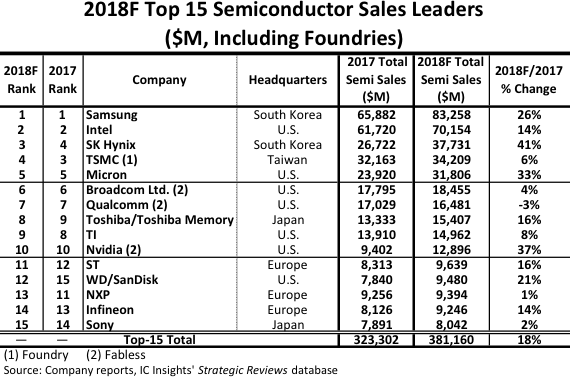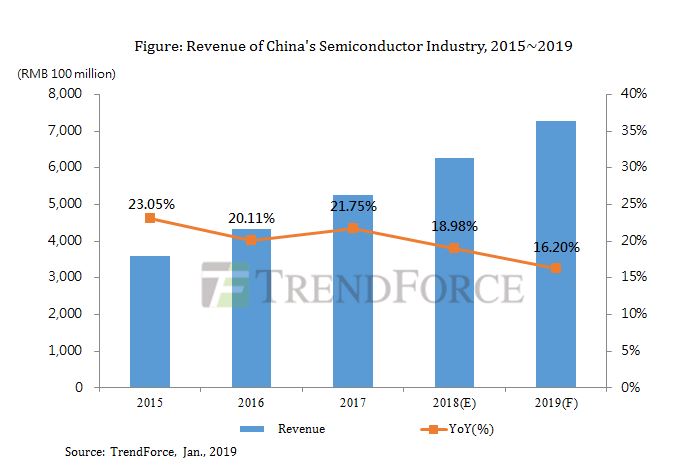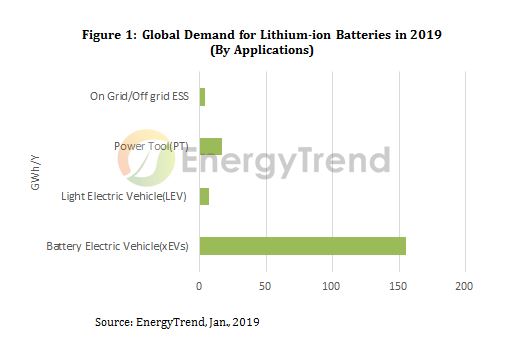Nine Top-15 2018 semi suppliers forecast to post double-digit gains
IC Insights’ November Update to the 2018 McClean Report, released later this month, includes a discussion of the forecasted top-25 semiconductor suppliers in 2018 (the top-15 2018 semiconductor suppliers are covered in this research bulletin). The Update also includes a detailed five-year forecast of the IC market by product type (including dollar volume, unit shipments, and average selling price).
The expected top-15 worldwide semiconductor (IC and O-S-D—optoelectronic, sensor, and discrete) sales ranking for 2018 is shown in Figure 1. It includes seven suppliers headquartered in the U.S., three in Europe, two each in South Korea and Japan, and one in Taiwan. After announcing in early April 2018 that it had successfully moved its headquarters location from Singapore to the U.S., IC Insights now classifies Broadcom as a U.S. company.
In 2Q18, Toshiba completed the $18.0 billion sale of its memory IC business to the Bain Capital-led consortium. Toshiba then repurchased a 40.2% share of the business. The Bain consortium goes by the name of BCPE Pangea and the group owns 49.9% of Toshiba Memory Corporation (TMC). Hoya Corp. owns the remaining 9.9% of TMC’s shares. The new owners have plans for an IPO within three years. Bain has said it plans to support the business in pursing M&A targets, including potentially large deals.
As a result of the sale of Toshiba’s memory business, the 2018 sales results shown in Figure 1 include the combined sales of the remaining semiconductor products at Toshiba (e.g., Discrete devices and System LSIs) and NAND flash sales from Toshiba Memory Corporation.
In total, the top-15 semiconductor companies’ sales are forecast to jump by 18% in 2018 compared to 2017, two points higher than the expected total worldwide semiconductor industry 2018/2017 increase of 16%. The three largest memory suppliers—Samsung, SK Hynix, and Micron—are each forecast to register greater than 25% year-over-year growth in 2018 with SK Hynix expected to log the highest growth among the top 15 companies with a 41% surge in sales this year. All of the top-15 companies are expected to have sales of at least $8.0 billion in this year, two companies more than in 2017. Nine of the top-15 companies are forecast to register double-digit year-over-year growth in 2018. Moreover, five companies are expected to have ≥20% growth, including four of the big memory suppliers (Samsung, SK Hynix, Micron, and Western Digital/SanDisk) as well as Nvidia.

Figure 1
The largest move upward in the ranking is forecast to come from Western Digital/San Disk, which is expected to move up three spots to the 12th position. In contrast, NXP is expected to fall two places to 13th with a sales increase of only 1% this year. However, the worst-performing company in the ranking is forecast to be Qualcomm with a semiconductor revenue decline of 3% this year, the only top-15 company expected to register a drop in sales.
Intel was the number one ranked semiconductor supplier in 1Q17 but lost its lead spot to Samsung in 2Q17. It also fell from the top spot in the full-year 2017 ranking, a position it had held since 1993. With the strong surge in the DRAM and NAND flash markets over the past year, Samsung is forecast to go from having 7% more total semiconductor sales than Intel in 2017 to having 19% more semiconductor sales than Intel in 2018.
Memory devices are forecast to represent 84% of Samsung’s semiconductor sales in 2018, up three points from 81% in 2017 and up 10 points from 71% just two years earlier in 2016. Moreover, the company’s non-memory sales in 2018 are expected to be only $13.3 billion, up only 6% from 2017’s non-memory sales level of $12.5 billion. In contrast, Samsung’s memory sales are forecast to be up 31% this year and reach $70.0 billion.
The top-15 ranking includes one pure-play foundry (TSMC) and three fabless companies. If TSMC were excluded from the top-15 ranking, Taiwan-based MediaTek would have been ranked in the 15th position with forecasted 2018 sales of $7.9 billion, up only 1% from 2017.
IC Insights includes foundries in the top-15 semiconductor supplier ranking since it has always viewed the ranking as a top supplier list, not a marketshare ranking, and realizes that in some cases the semiconductor sales are double counted. With many of our clients being vendors to the semiconductor industry (supplying equipment, chemicals, gases, etc.), excluding large IC manufacturers like the foundries would leave significant “holes” in the list of top semiconductor suppliers. Foundries and fabless companies are identified in the Figure. In the April Update to The McClean Report, marketshare rankings of IC suppliers by product type were presented and foundries were excluded from these listings.
Overall, the top-15 list is provided as a guideline to identify which companies are the leading semiconductor suppliers, whether they are IDMs, fabless companies, or foundries.
在线留言询价

Revenue Growth in China's Semiconductor Industry Would Slow Down to 16.2% in 2019 due to Pessimistic
- 一周热料
- 紧缺物料秒杀
| 型号 | 品牌 | 询价 |
|---|---|---|
| TL431ACLPR | Texas Instruments | |
| MC33074DR2G | onsemi | |
| BD71847AMWV-E2 | ROHM Semiconductor | |
| RB751G-40T2R | ROHM Semiconductor | |
| CDZVT2R20B | ROHM Semiconductor |
| 型号 | 品牌 | 抢购 |
|---|---|---|
| BP3621 | ROHM Semiconductor | |
| TPS63050YFFR | Texas Instruments | |
| IPZ40N04S5L4R8ATMA1 | Infineon Technologies | |
| ESR03EZPJ151 | ROHM Semiconductor | |
| BU33JA2MNVX-CTL | ROHM Semiconductor | |
| STM32F429IGT6 | STMicroelectronics |
- 周排行榜
- 月排行榜
AMEYA360公众号二维码
识别二维码,即可关注



























